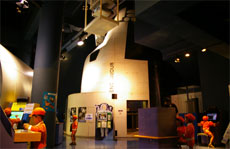Q. As director, what do you think is the role of the Tamarokuto Science Center? What are the roles of space and science in children's education?

The Tamarokuto Science Center
As an example, today, I talked to elderly visitors about the charm of the starry sky and about the bonds that exist between the stars and human beings. When you think that a star shares the same origins as your own body, you begin to look at stars in a different light. I'd like children to feel such bonds in the world where they live. The role of science is to accurately teach these bonds and connections, so that everyone can live in a more harmonious way with their immediate and global environment.
Everything in our world is linked to ourselves, and the better our understanding and care for this fact, the better we will survive as a society on Earth. Such wisdom grows when children experience or enjoy the bonds in nature discovered by science. Even if a child is not destined to become a scientist, if they understand the science behind human activities and the effects of our actions on nature and on the planet, I think our society will grow in a healthy manner. The role of the science center is to let visitors experience and learn about such bonds and links through space and science.
Q. What are some of the more interesting features of the Tamarokuto Science Center?

The Space Exhibition Area at Tamarokuto Science Center
There are a few! We have
- a full-size model of the Japanese Experiment Module Kibo for the International Space Station
- a 1/3 scale model of the Space Shuttle's cockpit
- Moon Walker, which allows people to experience 1/6 gravity like on the Moon
- a planetarium with a 27-meter diameter, with live commentary and panoramic movie screenings every day
- Earth Science and Life Science exhibits that teach visitors about things other than space in five different zones at our science center.
We hope that the system we have devised provides many ways to experience science and nature. For example, microscopic plankton live attached to the backs of leaves from the bushes around the science center. You can use a microscope to watch these tiny creatures in the study room of the science center.
Children can learn about the differences and connections between the macro- and micro-worlds by looking at the things around them from different viewpoints, ranging from tiny things seen with microscopes to expansive views from space.
Experience is a great way to acquire knowledge. To experience something is not just to look at it physically, but also to see it with your mind. In the famous story The Little Prince, Antoine de Saint-Exupéry writes, "If you don't see with your mind, it's not a real thing." I think that's true.
Visitors of all generations come to our science center. These days, in a modern city, there may be few opportunities for a grandchild and a grandfather to look at a starry sky together. However, if they come to the planetarium at our science center, they can still enjoy the starry sky together. Another event at Tamarokuto Science Center is displaying strips of paper with individuals' and families' wishes written on them, during the Star Festival. I hope our science center can be a place to maintain the important connection between generations through such events.
Q. What kind of activity do you want to do next?

When I go to the study room at science center, I can meet many small children and talk about many things with them, and that is interesting. Also, when I answer questions on the radio from children during the Children's Telephone Consultation on Science during the Summer Holiday program, I receive so many things from them in return. The important thing is to make conversation with them. By talking to them directly, you can find out why children have such questions. It is very important to know the origin of the question to give a correct answer. If, after you feel you've explained a thousand times, a child still doesn't understand, maybe it's because you are attacking the information from the wrong angle. I will continue to meet and exchange dialogue with various people, and enjoy what I learn as well as what I teach during those times.